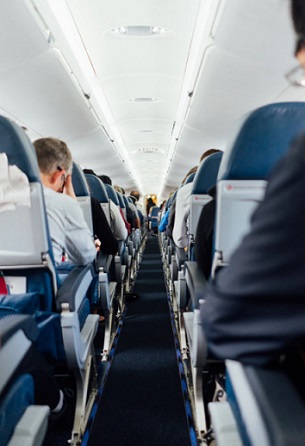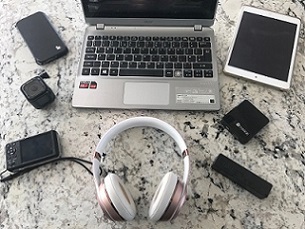 The last place you want a lithium battery fire is in the confined space of a passenger aircraft
The last place you want a lithium battery fire is in the confined space of a passenger aircraft
 All these everyday electronic gadgets are powered by lithium-ion batteries
All these everyday electronic gadgets are powered by lithium-ion batteries
 An AvSax lithium battery fire mitigation bag
An AvSax lithium battery fire mitigation bag
 The AvSax lithium battery fire mitigation bag won the Queen's Award for Enterprise - the highest accolade any business can get in the UK
The AvSax lithium battery fire mitigation bag won the Queen's Award for Enterprise - the highest accolade any business can get in the UK
Most airlines now include a warning about the dangers of lithium battery fires in their pre-flight safety briefing.
Although the cabin crew will probably tell passengers to alert them immediately if their phone, laptop or other personal electronic device (PED) overheats or gets lost in the seat, the reason is the real risk of a toxic fire on board.
But why do lithium batteries catch fire on planes?
Well, if the PED gets lost in the seat and damaged by its mechanism there is a risk the lithium batteries inside will get crushed, causing them to catch fire or even explode.
Also, if devices are used with cheap chargers or batteries that don’t meet safety standards – and many people take this risk – then they could just simply overheat and catch fire at any time.
This ever-present danger is recognised by one of the world’s biggest aircraft manufacturers, Airbus, which reveals that traditional firefighting measures won’t work on lithium battery fires.
This is because once lithium batteries overheat they can quickly go into what’s known as thermal runaway, a rapid, uncontrolled chemical reaction within the battery that causes the internal temperature to rise.
When one cell in a battery overheats it can produce enough heat - up to 900°C (1652°F) - to make adjacent cells overheat too.
The Airbus report says this leads to the risk of an explosion, stating: “Reacting to a lithium battery fire in the cabin starts with isolating the source of fire. Indeed, a smoking battery may explode at any time due to the highly exothermic thermal runaway.”
Speed and subsequent peace of mind is vital and this is why many airlines use award-winning AvSax fire and smoke mitigation bags that use liquid inside them to keep the overheating battery cool.
AvSax, which won the prestigious Queen’s Award for Enterprise in the UK, are also known as ‘burn bags’ and are now on more than 15,373 aircraft operated by 80 airline companies worldwide. They have been used 33 times to deal with emergencies since the start of 2017 and every time they have been deployed the aircraft has been able to complete its journey safely with no need to divert or make an emergency landing.
The Airbus report states: “Classical firefighting procedures and fire extinguishing are not efficient to stop a lithium battery fire.
“Halon can suppress open flames but it’s ineffective in addressing the source of fire. Use of water is the best option to allow cooling and limit the propagation to adjacent cells.
“Once a lithium battery cell has ignited then the effort must concentrate on cooling the surrounding cells by use of water (or other non-alcoholic liquid) and preventing deterioration of the situation to avoid any fire propagation to the adjacent battery cells.”
AvSax battery fire mitigation bags do have this vital cooling aspect built into their design which makes them so effective in the way they work to contain overheating lithium-ion batteries. The material is military grade so if the device explodes it will all be contained within the AvSax.
Airbus is concerned at the number of lithium battery fires that have happened on aircraft.
It states: “Several events have occurred on aircraft, ranging from localised and limited fires to large, uncontrolled in-flight fires resulting in hull losses and fatalities.”
In the USA alone, the Federal Aviation Administration reports that up to July 1, 2022, there have been 375 aviation related incidents involving lithium batteries carried as cargo or baggage recorded since January 23, 2006. Many of the batteries were in personal electronic devices (PEDS) such as headphones, mobile phones, laptops and even e-cigarettes.
The Airbus report adds: “Federal Aviation Administration tests show that even a small number of overheating batteries emit gases that can cause explosions and fires that cannot be prevented by traditional fire suppression systems. In view of the possible consequences, lithium batteries are classified as hazardous materials so particular care and consideration must be taken to ensure safe operations in relation to use and transport of lithium batteries (or devices containing lithium batteries) when in an aircraft environment.”
Airbus also says all personal electronic items and spare batteries must be taken into the passenger compartment and never put in the hold as the automatic fire suppression systems in there can’t cope with the exceptional heat and intensity of a lithium battery fire.
This use of liquid is recommended by the Civil Aviation Authority in the UK and, unlike AvSax, many other fire containment bags don’t work this way.
In its guidance the CAA states: “Since the development of the International Civil Aviation Organization (ICAO) guidance on dealing with an in-flight battery fire, new products designed for use in response to lithium battery thermal runaway events have become available.
“Products which provide both a cooling and containment capability are typically more aligned to the existing ICAO guidance as when used they are filled with water or other non-flammable liquid to act as a cooling agent.
“After knocking down flames it could conceivably take just a couple of seconds for a personal electronic device to be placed inside a containment bag, allowing it to be moved to a place of safety. Passengers could then return to their seats, mitigating potential unrelated safety hazards such as injury in the case of severe turbulence. Equally, the effect on flight crew in carrying out their duties following an event on the flight deck would be minimised.”